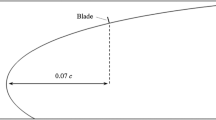Abstract
The reattachment of post-stall separated flow on a NACA 0025 airfoil at a Reynolds number of 100,000 and angle-of-attack of 12\(^\circ\) using synthetic jet control was studied experimentally. The goal of this work was to study the effect of control parameters including blowing ratio, frequency, and in particular, slot location, on aerodynamic performance. Slot locations both upstream and downstream of the mean separation point were tested. The results showed that for both drag reduction and lift increase, once a particular blowing ratio was met, the benefits of control saturated. Positioning the slot at the most upstream location was found to be the most effective, both in terms of having the lowest threshold blowing ratio and producing the largest lift-to-drag ratios. A monotonic increase in threshold blowing ratio (defined as being the blowing ratio required for fully attached flow) and decrease in lift-to-drag was observed as the slot location moved downstream. It was also found that while forcing at a frequency corresponding to the wake instability led to maximum lift increase, forcing in the range of the separated shear layer instability (frequencies an order of magnitude larger) led to maximum drag reduction.















Similar content being viewed by others
References
Amitay M, Glezer A (2002a) Controlled transients of flow reattachment over stalled airfoils. Int J Heat Fluid Flow 23(5):690–699
Amitay M, Glezer A (2002b) Role of actuation frequency in controlled flow reattachment over a stalled airfoil. AIAA J 40(2):209–216
Amitay M, Smith DR, Kibens V, Parekh DE, Glezer A (2001) Aerodynamic flow control over an unconventional airfoil using synthetic jet actuators. AIAA J 39(3):361–370
Becker R, King R, Petz R, Nitsche W (2007) Adaptive closed-loop separation control on a high-lift configuration using extremum seeking. AIAA J 45(6):1382–1392
Boutilier MS, Yarusevych S (2012) Parametric study of separation and transition characteristics over an airfoil at low Reynolds numbers. Exp Fluids 52(6):1491–1506
Boutilier MS, Yarusevych S (2012) Separated shear layer transition over an airfoil at a low reynolds number. Phys Fluids 24(8):084,105
Brendel M, Mueller TJ (1988) Boundary-layer measurements on an airfoil at low Reynolds numbers. J Aircraft 25(7):612–617
Buchmann N, Atkinson C, Soria J (2013) Influence of znmf jet flow control on the spatio-temporal flow structure over a naca-0015 airfoil. Exp Fluids 54(3):1–14
Dovgal AV, Kozlov VV, Michalke A (1994) Laminar boundary layer separation: instability and associated phenomena. Progress Aerosp Sci 30:61–94
Dovgal V, Kozlov VV (1983) Influence of acoustic pertubations on the flow structure in a boundary layer with adverse pressure gradient. Fluid Dyn 18:205–209
Feero MA, Goodfellow SD, Lavoie P, Sullivan PE (2014) Flow reattachment using synthetic jet actuation on a low-reynolds-number airfoil. AIAA J 53(7):2005–2014
Feero MA, Lavoie P, Sullivan PE (2015) Effects of wind tunnel model end conditions on low Reynolds number airfoil studies. In: 25th Canadian congress of applied mechanics
Feero MA, Lavoie P, Sullivan PE (2016) Time- and phase-averaged boundary layer measurements on a controlled NACA 0025 airfoil. In: ASME 2016 fluids engineering division summer meeting
Feero MA, Lavoie P, Sullivan PE (2017) Three-dimensional span effects of high-aspect ratio synthetic jet forcing for separation control on a low Reynolds number airfoil. J Vis 20(1):45–51
Glezer A (2011) Some aspects of aerodynamic flow control using synthetic-jet actuation. Philos Trans R Soc A Math Phys Eng Sci 369(1940):1476–1494
Greenblatt D, Paschal KB, Chung-Sheng Y, Harris J (2006) Experimental investigation of separation control part 2: zero mass-flux oscillatory blowing. AIAA J 44(12):2831–2845
Greenblatt D, Wygnanski IJ (2000) The control of flow separation by periodic excitation. Progress Aerosp Sci 36(7):487–545
Hsiao FB, Shyu JY, Liu CF (1990) Control of wall-separated flow by internal acoustic excitation. AIAA J 28(8):1440–1446
Lang M, Rist U, Wagner S (2004) Investigations on controlled transition development in a laminar separation bubble by means of lda and piv. Exp Fluids 36(1):43–52
Lissaman PBS (1983) Low-Reynolds-number airfoils. Annu Rev Fluid Mech 15:223–239
O’Meara M, Mueller T (1987) Laminar separation bubble characteristics on an airfoil at low reynolds numbers. AIAA J 25(8):1033–1041
Packard NO, Thake MP Jr, Bonilla CH, Gompertz K, Bons JP (2013) Active control of flow separation on a laminar airfoil. AIAA J 51(5):1032–1041
Seifert A, Darabi A, Wyganski I (1996) Delay of airfoil stall by periodic excitation. J Aircraft 33(4):691–698
Smith BL, Glezer A (1998) The formation and evolution of synthetic jets. Phys Fluids 10:2281
Wu JZ, Lu XY, Denny AG, Fan M, Wu JM (1998) Post-stall flow control on an airfoil by local unsteady forcing. J Fluid Mech 371(1):21–58
Yarusevych S (2006) Investigation of airfoil boundary layer and turbulent wake development at low Reynolds numbers. PhD Thesis
Yarusevych S, Kotsonis M (2017) Steady and transient response of a laminar separation bubble to controlled disturbances. J Fluid Mech 813:955–990
Yarusevych S, Sullivan PE, Kawall JG (2009) On vortex shedding from an airfoil in low-Reynolds-number flows. J Fluid Mech 632:245–271
Acknowledgements
The authors would like to acknowledge support from the Natural Sciences and Engineering Research Council of Canada, CMC Microsystems, and Lyon Sachs.
Author information
Authors and Affiliations
Corresponding author
Rights and permissions
About this article
Cite this article
Feero, M.A., Lavoie, P. & Sullivan, P.E. Influence of synthetic jet location on active control of an airfoil at low Reynolds number. Exp Fluids 58, 99 (2017). https://doi.org/10.1007/s00348-017-2387-x
Received:
Revised:
Accepted:
Published:
DOI: https://doi.org/10.1007/s00348-017-2387-x




